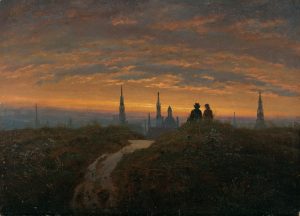
Carl Gustav Carus (1789–1869)
Blick auf Dresden bei Sonnenuntergang, um 1822 / View of Dresden at Sunset, ca. 1822
The picture shows the artist’s view of his adopted home Dresden, where he lived since 1814. The silhouette of the city’s spires is visible behind a hill traversed by a narrow path, which, freely composed, reveals some of Dresden’s towers. The large dome of the Frauenkirche, built in 1743 by George Bähr, is clearly visible. Seemingly lost in thought, a couple contemplates the extraordinary colorfulness of the sunset.
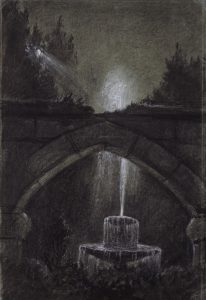
Carl Gustav Carus (1789–1869)
Springbrunnen hinter Torbogen im Mondschein, 1867 / Fountain behind Archway in Moonlight, 1867
Carl Gustav Carus was a talented polymath: writer, philosopher, doctor, scientist and artist. His atmospheric moon landscape was created two years before his death. The drawing bears the following inscription on the cardboard underlay: “To new seeing – new visible! Thus, through a better understanding, man is striding towards a higher understanding of a new-seeing person! Carus June, 4, 1867.” On the back of the drawing there is a note explaining the text on the front: “Charcoal drawing by C. Carus Sr., made for Aunt Luise after the first eye operation.”
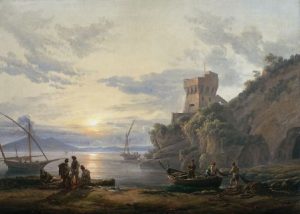
Johan Christian Dahl (1788–1857)
Küste Nahe Castellammare im Morgendunst, 1822 / Coast near Castellammare in Morning Mist, 1822
In 1818, the Dresden art world was amazed when the painter, who was born in Bergen, Norway, became a resident of this city and lived there in a house with Caspar David Friedrich. He inspired with unusual new, monumental landscapes and a sovereign application of color. A little later he became a member and professor at the Royal Academy of Fine Arts. The painting commemorates his one-year trip to Italy from 1820 to 1821, when he found this motif on the Gulf of Naples, near Vesuvius. Still timidly, the rising sun shines through the morning mist and illuminates a calm scene. In the small bay next to one of the typical watchtowers of the region fishermen prepare their nets.
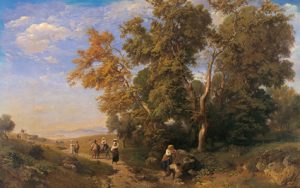
Heinrich Dreber (1822–1875)
Wäscherinnen am Nemisee, 1851–1853 / Washerwomen at Nemisee, 1851–1853
The landscape painter Heinrich Dreber, also called Heinrich Franz-Dreber, was a pupil of Ludwig Richter in Dresden and lived in Rome from 1843 until his death. Dreber created the large-format drawing for his patron Heinrich Wilhelm Campe. He had got to know the Leipzig collector in the winter of 1846/47 in Rome with his innkeepers. In the foreground of the ideally constructed landscape is a mighty group of trees with a sculptural effect. On the shore of the lake, framed by trees and antique stone blocks, the artist has painted a group of washerwomen draped in picturesque fashion. The figures are lightly colored with light watercolors, while the drawing, with the exception of a few washes around the water and the mountains, was otherwise executed only with pencil.
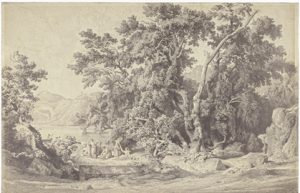
Heinrich Dreber (1822–1875)
Campagnalandschaft mit Eichen, 1859 / Campagna landscape with Oaks
Influenced by the ideal landscape painting, Heinrich Dreber developed a painting style tending towards a realistic view. He found his motifs, as in this painting, in the immediate vicinity of Rome. The composition of the depiction is similar to the composition of the drawing Wäscherinnen am Nemisee (Washerwomen at Lake Nemi) in this exhibition: a group of trees dominating the picture offers a view of the barren plain and the mountains that follow. At the small stream, country people find shelter from the summer heat and refreshment in the shade of the vegetation. Ruins and villages on the surrounding hills are hinted at in a hazy distance.
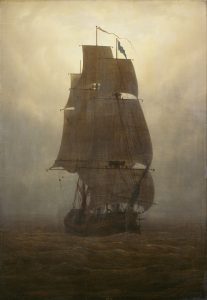
Caspar David Friedrich (1774–1840)
Segelschiff, um 1815 / Sailing Ship, ca. 1815
Ships as a pictorial motif can be found in several of Caspar David Friedrich’s paintings. But here he concentrates entirely on the motif of an isolated frigate on the open sea in front of a foggy ground. Caspar David Friedrich was familiar with the sea and shipping from childhood on. Not far from his parents’ house was the port of Greifswald. But the landscape is not sketched after nature. Possibly a miniature model of a Danish frigate ship, which was in his studio, served as a model for him. Pay attention to the small details. A shadowy figure in the middle ground appears very tiny. Man seems small in light of technology and the vast expanse of nature.
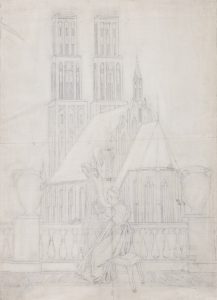
Caspar David Friedrich (1774–1840)
Die Harfenspielerin (Allegorie der religiösen Musik), um 1830 / Woman Playing Harp (Allegory of Religious Music), ca. 1830
The church is the old parish church of St. Jacobi in Greifswald. Friedrich changed the architecture and added an imposing double-tower facade and a decorative gable. The leaf is partially pinned and blacked out with chalk on the back, indicating that the motif has been transferred to another medium. The harpist is considered to be a preliminary sketch for a cycle of pictures with leaves from the Hamburg Kunsthalle and the Paris Louvre, whose compositions represented the allegories of secular, religious and heavenly music. The Chemnitz drawing embodies religious music.
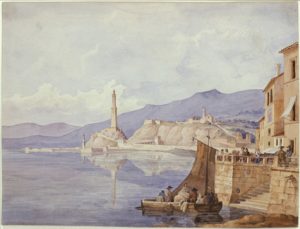
Carl Wilhelm Götzloff (1799–1866)
Hafen von Genua, 1835 / Genoa Harbour, 1835
After his studies at the Academy of Arts in Dresden, a travel scholarship in 1821 enabled Carl Wilhelm Götzloff to undertake a longer study trip to Italy. The artist lived in Italy for over 40 years until his death and was one of the most important landscape and genre painters there. In 1935 he captured the port of Genoa in a watercolor. The reduction of the color palette to brown and blue tones is striking, with the sky and mountains corresponding in color to the blue of the sea.
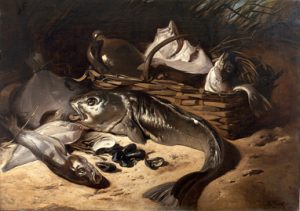
Charles Hoguet (1821–1870)
Fischstillleben, 1849 / Fish Still Life, 1849
At first sight it seems as if Hoguet had already anticipated a little bit of surrealism. The fish in his still life at least develop a strange life of their own. Rather limp, struggling for air and hardly fresh at all – quite different from the baroque splendor of a typical Dutch still life – the catch, lying on the ground, perhaps left behind, presents itself. In the basket, a lying profile of a man emerges. The slightly tilted jug seems empty and exhausted.
Charles Hoguet had been a Berlin-based artist since 1848. He created countless oil paintings, including seascapes, naval paintings and windmills.
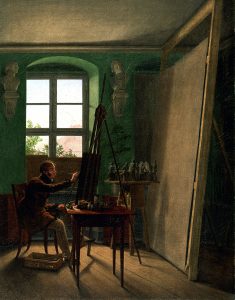
Georg Friedrich Kersting (1785–1847)
Der Maler Matthäi im Atelier, 1812 / The Painter Matthäi in his Studio, 1812
The artist friend of Caspar David Friedrich shows his colleague Matthäi painting in his studio in a fine painting style. Before the restoration in 1996, the painting was covered by a heavily browned varnish and insensitive over-painting. The paint box with the signature and the painter’s studio skirt had been heavily altered. After intensive preliminary examinations with microscope and UV-fluorescence, the over-paintings were removed with different solvent mixtures under the microscope. The painting layer was relatively heavily damaged. Through a careful retouching with watercolors, the painting layer was brought back closer to the original.
Detlef Göschel, painting restorer
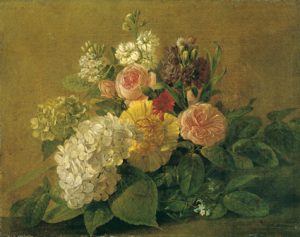
Kersting.tif
Georg Friedrich Kersting (1785–1847)
Blumenstilleben, um 1830/39 / Flowers, ca. 1830/39
Georg Friedrich Kersting attained great fame with his paintings of interiors. The most famous is, besides the painter Matthäi in the studio shown here, the depiction of his friend Caspar David Friedrich in the studio. When he took over the position as head painter at the Royal Porcelain Manufactory in Meissen in 1818, his artistic activities were largely devoted to designing shapes and decorations and to instructing the employees under his supervision. During this time he created two independent flower still lifes, which are a special feature of his oeuvre. One of them can now be admired here.
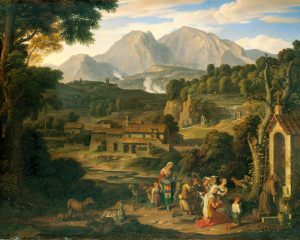
Joseph Anton Koch (1768–1839)
Kloster San Francesco Di Civitella mit Kreuzwegstationen, 1814 / Monastery of San Francesco Di Civitella with Stations of the Cross, 1814
Nestled in an imposing mountainous landscape is the Monastery of San Francesco di Civitella, built in memory of a stay of St. Francis in 1224. In the foreground of the picture a monk kneels at a station of the cross, followed by a group of devout prayers. Following the course of the river, the observer’s gaze reaches a Stations of the Cross, which runs behind the monastery.
In 1794 Joseph Anton Koch wandered over the Alps to Italy, where he lived with a short interruption until his death. In numerous memoirs of German painters who lived temporarily in Rome, he is mentioned as an outstanding teacher and friend.
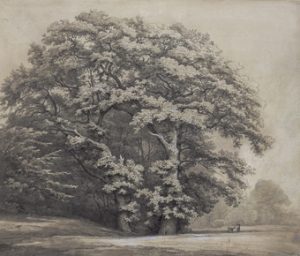
Carl Robert Kummer (1810–1889)
Eichen an der Waldwiese mit Hirsch und Hirschkuh, 1846 / Oak Trees at the Forest Meadow with Deer and Doe, 1846
The drawing with the group of trees and the deer grazing in the shade of the oaks was probably made in Wörlitz Park near Dessau. Kummer stayed there for a long time in 1846. The sheet is part of the extensive donation of the Chemnitz lawyer, collector and amateur painter Dr. Helmut Brückner (1899-1977). He was particularly interested in the drawing art of the 19th century, especially the artists from the circle of the Dresden Romanticism. On the occasion of the 800th anniversary of the city of Karl-Marx-Stadt (today Chemnitz) in 1965, one year later he donated his collection of over 3000 sheets to the Graphic Arts Collection.
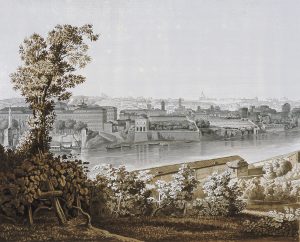
Carl Robert Kummer (1810–1889)
Blick auf einen Teil von Rom, 1832 View of a Part of Rome, 1832
With its masterpieces of art history, Rome had an enormous attraction for German artists. After studying at the Academy of Art in Dresden, Kummer’s artistic development was mainly influenced by travel. A scholarship from the Academy of Art in 1932 enabled him to study in Italy for several years. The artist’s gaze is directed over the Tiber towards the striking buildings of St. Peter’s Church and the Vatican. In order to enhance the depth of the view, he used a sharp, hard pencil for the distant background, while in the foreground he set soft accents with brown ink.
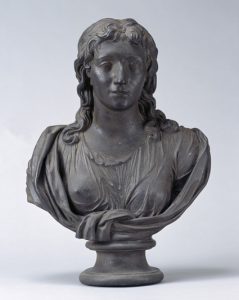
Joseph Mattersberger (1754–1825)
Weibliches Bildnis, o. J. / Guss 1789/1802 */ Female Portrait, n.d. / Cast 1789/1802
This portrait of a woman in an antique gown is described in literature as a portrait of Countess Louise Henriette von Wallwitz. However, it bears no resemblance to the surviving portraits of the Countess. This bust belongs to the early iron castings that Mattersberger perfected for the local foundry in Lauchhammer. Iron, as a decisive material in the Industrial Revolution, thus also gained increasing importance in the art of the 19th century alongside the usual bronze.
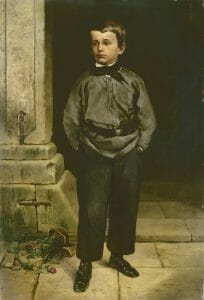
Ferdinand von Rayski (1806–1890)
Konrad von Posern (1842–1851), 1851 / Konrad von Posern, 1851
A boy stands as a full-length figure with his hands in his pockets and a gaze directed into the void in the foreground. He is framed by a stone-gray gate leading into the dark. The almost nine-year-old boy wears dark blue trousers, a gray smock with a black belt and black neck tie. Next to him on the floor, a fallen, broken flower pot catches his eye. Ferdinand von Rayski painted the boy on behalf of his parents in Schloß Pulsnitz, but only after the boy’s early death. The child died of scarlet fever. The portrait is thus a memorial picture, which not only serves the private memory, but also fulfilled a representative function for the ancestral gallery of the Saxon noble family until it was sold in the art trade in 1926.
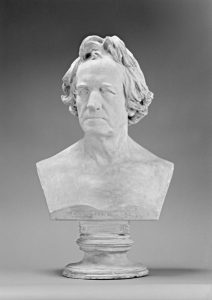
Ernst Rietschel (1804–1861)
Christian Rauch, 1857 / Guss vor 1872 / Christian Rauch, 1858 / Cast before 1872
The classicist sculptor Christian Daniel Rauch was Ernst Rietschel’s teacher and is known for his portraits close to nature. In 1857, his pupil, in admiration of Rauch, set about creating lifelike portraits of his mentor. As a model he used a clay cast of Rauch’s self-portrait bust from 1828. Because of its high quality, the bust quickly became popular in the form of plaster casts. Rietschel himself executed it three more times in marble.
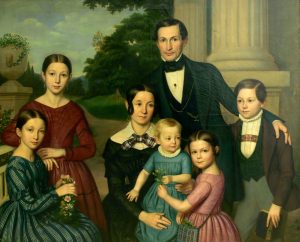
Friedrich Gottlob Schreiber (1809 – 1888)
Familienbild Justizrat Dr. Emmrich, 1849 / Family Portrait Judicial Council Dr Emmrich, 1849
The painting is one of the artist’s largest and most figured works. The painter had moved from Mittweida to Chemnitz around 1839 and was one of the most respected personalities in the city. Friedrich Gottlob Schreiber ran a photo studio in Chemnitz and, as an academic painter, mainly produced portraits. Among his commissions is this magnificent Biedermeier family portrait of Dr. Carl August Emmrich (1809-1881), who was also born in Mittweida. The Councillor of Justice is portrayed with his wife Emilie Louise and the children in bourgeois clothing against a magnificent park-like backdrop.
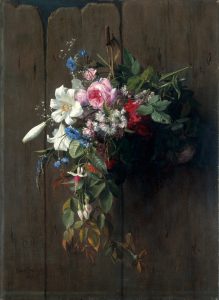
Clara von Sivers (1854-1924)
Blumenstück, 1877 / Flowers, 1877
With her large pictures of flowers, birds and fruit, the young artist already inspired her contemporaries in Kiel with exhibitions around 1873. A tasteful composition, richness of detail and virtuosity in execution also characterize the “Bouquet of Flowers at the Board Fence”, which unfolds the effect of a “trompe-l’œil”; a deceptively genuine illusionist painting, which suggests three-dimensionality by means of perspective representation. At the end of 1875, the talented artist founded a painting school with her sisters, where she taught young ladies. She married, separated again and remained true to painting, while at the same time increasingly focusing on decorative art.
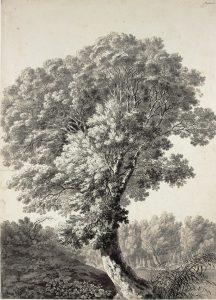
Johann Conrad Steiner (1757–1818)
Alter Baum am Wasser, o. J. / Old Tree at the Water, n. d.
For the Swiss painter Johann Conrad Steiner, forest, trees and nature represented idyllic places of longing, typical of a romantic artist. The fact that the picture Alter Baum am Wasser (Old Tree by the Water) was drawn from a rather irrational perspective, although artistically very skillful, can be seen, for example, in the fact that the wind seems to come from different directions. Do you recognize it?
The view from outside: Dr. Lars Dietrich, 32, teacher and botanist
Carl Thieme (1816–1884)
Blick vom Schloßberg auf Chemnitz, 1870 / View from the Schloßberg at Chemnitz, 1870
In a romantic evening mood, the painting captures the view from the Schlossberg over the castle pond towards the city centre. From the right, the east wing of the former Benedictine monastery slides into the picture. At the time of the painting’s creation, it housed the Schloßgarten (Castle Garden) restaurant, run by the Beyreuther family, who possibly had themselves depicted in the form of the staffage figures. The terraces were also included in the inn, from where there were attractive views of the historic towers of the town center. The chimneys of the Sächsische Maschinenfabrik have now become an unmistakable competitor to them.
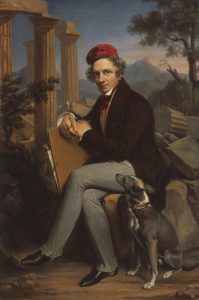
Carl Christian Vogel von Vogelstein (1788–1868)
Freiherr Otto Magnus von Stackelberg, 1831 / Baron Otto Magnus of Stackelberg, 1831
The portrait shows the painter and archaeologist Otto Magnus Freiherr von Stackelberg (1787-1837). In a representative pose, he is sitting with his portfolio and pencil in front of the impressive ruins of a Greek temple. It is the temple of Apollon Epicurios near Bassae in the Peloponnese in Greece, which the baron had helped to uncover. His drawings and studies as well as his knowledge of Greek and Roman antiquity were highly valued. The sitter became co-founder of the German Archaeological Institute in Rome. The painting itself was painted in Dresden in 1831 by the equally highly regarded painter and portraitist Vogel, who had been raised to the nobility by the King of Saxony.
Adrian Zingg (1734–1816)
„Schlos und Kirch bei Kemniz“, 1774 / “Castle and Church near Kemniz”, 1774
Adrian Zingg, one of the most important representatives of landscape painting in the 18th
century, documents the complex of the former Benedictine monastery as it was formed between 1480 and 1530. The changes that took place during the conversion to a castle after 1550 are also clearly visible. The building stock suffered considerable losses due to demolition only a few years after its creation, with the loss of the New Abbey (in the middle of the picture) being particularly serious. In this respect, the depiction has an important documentary role in addition to its artistic rank.
Provenance research at the Kunstsammlungen Chemnitz
The systematic investigation of the provenance of the drawings and prints acquired for the museum between 1933 and 1945 is the focus of a two-year, publicly funded research project in the Graphic Arts Collection. The aim is to clarify all previous ownership and possession of the objects as completely and comprehensibly as possible. In the event of an unlawful acquisition by the museum, the aim is to find the rightful former owner or his or her legal successors. Among the works currently under investigation is the drawing by Caspar David Friedrich, purchased in the art trade in 1935.
From 2013 to 2015, the Museum am Theaterplatz has already been researching the stories of origin of the works in the Painting and Sculpture Collection acquired during the National Socialist era.

